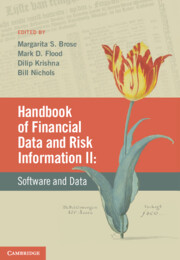Book contents
- Frontmatter
- Contents
- List of contributors
- Preface
- VOLUME II: SOFTWARE AND DATA
- PART IV DATA OPERATIONS IN FINANCIAL INSTITUTIONS
- PART V DATA MANAGEMENT TECHNOLOGIES
- 19 Financial data interchange standards
- 20 Data storage and processing
- 21 The extracting, transforming and transmitting of data
- 22 The visual analysis of financial data
- 23 Metadata management
- 24 Data security and privacy
- PART VI IMPLEMENTATION OF DATA AND ANALYTICS PROGRAMS
- Index – Volume II
23 - Metadata management
from PART V - DATA MANAGEMENT TECHNOLOGIES
- Frontmatter
- Contents
- List of contributors
- Preface
- VOLUME II: SOFTWARE AND DATA
- PART IV DATA OPERATIONS IN FINANCIAL INSTITUTIONS
- PART V DATA MANAGEMENT TECHNOLOGIES
- 19 Financial data interchange standards
- 20 Data storage and processing
- 21 The extracting, transforming and transmitting of data
- 22 The visual analysis of financial data
- 23 Metadata management
- 24 Data security and privacy
- PART VI IMPLEMENTATION OF DATA AND ANALYTICS PROGRAMS
- Index – Volume II
Summary
Metadata management technology
In one of the less precise vocabularies commonly used in the capital markets industry, the term “metadata” is typically taken to be described as “data about data.” Heads nod in unison and seemingly knowing glances are exchanged by participants, taking it as read that everybody shares a common understanding of the term.
Dig a little deeper, though – by comparing databases used by financial firms, say – and the imprecision of this definition rapidly makes itself known. To a computer scientist or engineer this presents a baffling situation – multiple firms working with the same data content treating the universe differently based on individual, proprietary implementations. As is common across many areas of the capital markets, few if any standards or even best practice conventions exist.
For a business, this lack of standardization almost always results in constraints on the ability to scale up operations to an enterprise level in a quick and efficient manner. For the fast moving capital markets this can easily result in missed opportunities to engage in new business opportunities, thereby having a direct impact on growth and performance. Truly, metadata sits at the intersection of the business execution and the underlying supporting technology infrastructure.
- Type
- Chapter
- Information
- Handbook of Financial Data and Risk Information IISoftware and Data, pp. 327 - 355Publisher: Cambridge University PressPrint publication year: 2014



